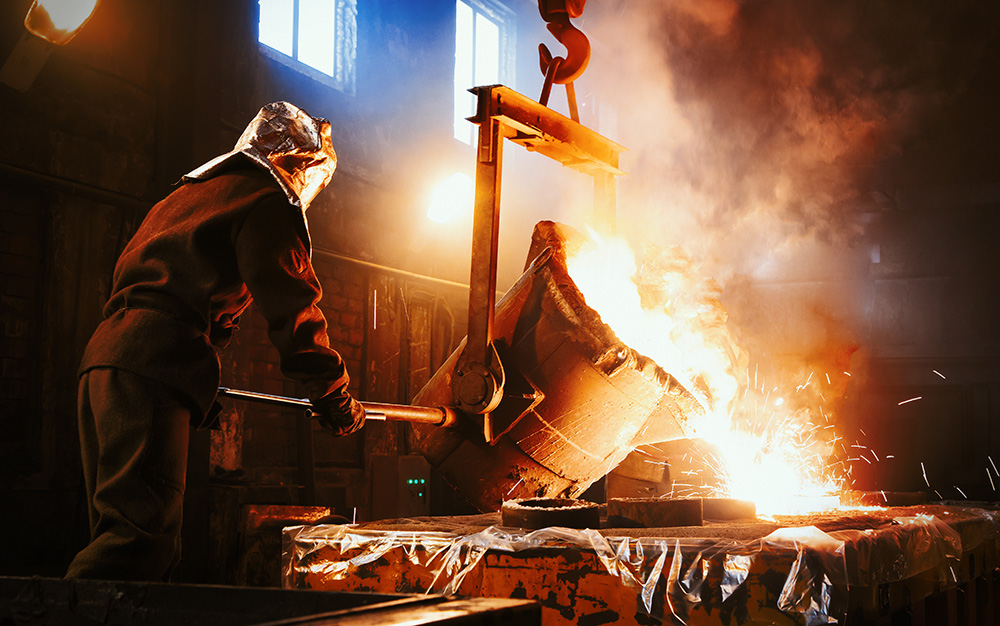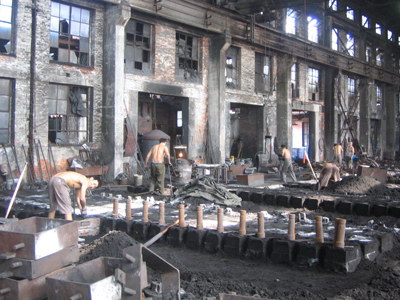Introducing the Complexities of Design and Production at a Metal Foundry
The design and production processes at a metal foundry include a series of detailed actions. Each phase, from picking resources to melting and spreading, plays an important function in the end product. Metal Casting. Accuracy and high quality control are paramount in this market. As technology advances, brand-new developments are emerging. These advancements may redefine conventional practices. What implications do these adjustments hold for the future of steel factories?
The Melting Process: Transforming Raw Products Into Liquid Metal
The melting procedure works as the critical very first step in transforming resources right into liquid metal, a procedure crucial for foundry procedures. This stage begins with the mindful choice of steels, which might consist of copper, light weight aluminum, or iron, depending on the wanted end product. Each product is examined for pureness and make-up to assure perfect melting problems.

As the metals reach their melting point, they convert from strong to liquid, enabling additional refinement. This process can likewise consist of the removal of impurities via slag development, guaranteeing the high quality of the liquid metal. Ultimately, the successful completion of the melting procedure lays the structure for succeeding metalworking operations.
Molding Techniques: Forming Metal With Precision
Adhering to the melting process, the following stage in metal foundry procedures includes molding methods that form the liquid metal into wanted kinds. Different approaches are utilized, each picked based on the specific requirements of the project. Sand casting, among the most common strategies, utilizes a combination of sand and binder to produce mold and mildews that can be easily formed and reused. An additional approach, investment casting, includes producing a wax pattern that is coated in a ceramic shell, enabling detailed designs and high precision.
Pass away casting, on the other hand, uses high-pressure to infuse liquified metal into steel mold and mildews, causing consistent and sturdy products. Furthermore, the option of molding technique impacts the cooling price, surface area coating, and dimensional accuracy of the last product. Consequently, comprehending these strategies is essential for optimizing layout and making certain the effective production of metal elements tailored to certain applications.
Casting Methods: From Model to Production
Various spreading approaches are utilized in steel foundries to move from prototype advancement to major manufacturing. Among these approaches, sand casting sticks out for its flexibility and cost-effectiveness, making it optimal for both little and large production runs. Financial investment spreading, recognized for its precision, is often made use of for complicated geometries, permitting great details in the end product. Die casting, ideal for high-volume manufacturing, makes use of molten metal infused right into mold and mildews, providing excellent surface coating and dimensional accuracy.

Quality Assurance: Ensuring Quality in Every Pour
While the casting procedure can differ greatly in between techniques, maintaining extensive quality control is vital to ascertain that every pour meets the needed criteria. Quality control in a metal foundry encompasses a collection of organized checks and analyses created to determine flaws early in the production process. This consists of meticulous evaluations of basic materials, tracking of melting temperatures, and evaluations of mold stability.
Foundry employees employ different testing methods, such as non-destructive testing and dimensional verification, to ascertain that spreadings accomplish wanted specs. In addition, adherence to developed sector criteria and qualifications boosts the reliability of the last item.
Feedback loops are likewise crucial; any kind of discrepancies kept in mind throughout high quality evaluations are evaluated to improve processes and minimize future errors. Inevitably, a society of high quality guarantee cultivates not only client complete satisfaction however additionally a track record for quality in the affordable landscape of steel manufacturing.
Technologies and Technologies: The Future of Metal Foundries
The landscape of metal shops is rapidly evolving, driven by improvements in technology and cutting-edge practices. Automation and robotics are transforming typical process, enhancing performance and precision during production. Automated pouring dig this systems and robot arms decrease human mistake, resulting in better outputs. In addition, the assimilation of fabricated intelligence is allowing anticipating upkeep, maximizing equipment efficiency, and lessening downtime.
Additive production is emerging as a game-changer, enabling rapid prototyping and the production of complicated geometries that were previously unattainable. This innovation promotes the customization of steel components, accommodating details client needs without substantial time hold-ups.
Sustainability is additionally a vital emphasis, with foundries adopting greener practices, such as recycling scrap metal and making use of energy-efficient furnaces. These advancements not just boost efficiency but likewise straighten with international initiatives towards eco liable production, guaranteeing the future of metal foundries stays competitive and durable in a changing industrial landscape.
Frequently Asked Concerns
What Sorts of Metals Are Frequently Used in Foundries?
Usual steels made use of in shops include aluminum, cast iron, brass, bronze, and steel (Metal Casting). Each metal possesses one-of-a-kind homes, making them ideal for different applications in industries like vehicle, aerospace, and construction, to name a few
Just How Do Shops Take Care Of Waste and Environmental Effect?
Foundries handle waste and environmental influence by implementing recycling programs, using advanced filtration systems, and sticking to strict governing criteria. They commonly invest in sustainable modern technologies to decrease discharges and advertise liable source usage throughout their operations.
What Safety and security Steps Are in Place for Workers?
Factories execute numerous safety procedures for employees, including individual protective devices, correct air flow systems, regular safety training, emergency situation response protocols, and stringent adherence to work-related wellness guidelines to lessen threats connected with hazardous materials and tools.
For how long Does the Entire Manufacturing Process Generally Take?
The entire manufacturing procedure typically takes a number of weeks, depending on the complexity of the style and the products used. Aspects such as mold and mildew prep work, melting, and cooling time substantially affect the overall period of manufacturing.
What Are the Main Challenges Dealt With by Metal Foundries Today?
Metal factories today deal with challenges such as increasing material expenses, varying demand, ecological policies, proficient labor scarcities, and keeping quality assurance. These problems make complex production effectiveness and earnings in an increasingly competitive market.
The layout and production processes at a metal foundry entail a series of elaborate actions. The melting procedure offers as the critical first action in use this link transforming raw materials into fluid steel, a procedure crucial for foundry procedures. Following the melting procedure, the next phase in metal foundry operations includes molding strategies that form the fluid metal right into wanted kinds. Many spreading techniques are used in metal factories to move from model advancement to major production. Quality control in a metal foundry includes a collection of organized checks and look here analyses made to identify problems early in the production process.